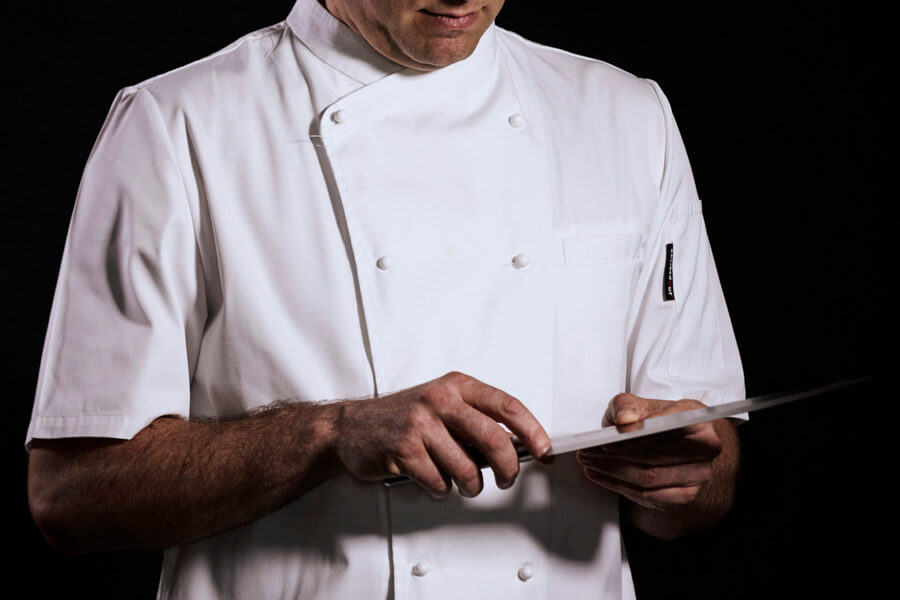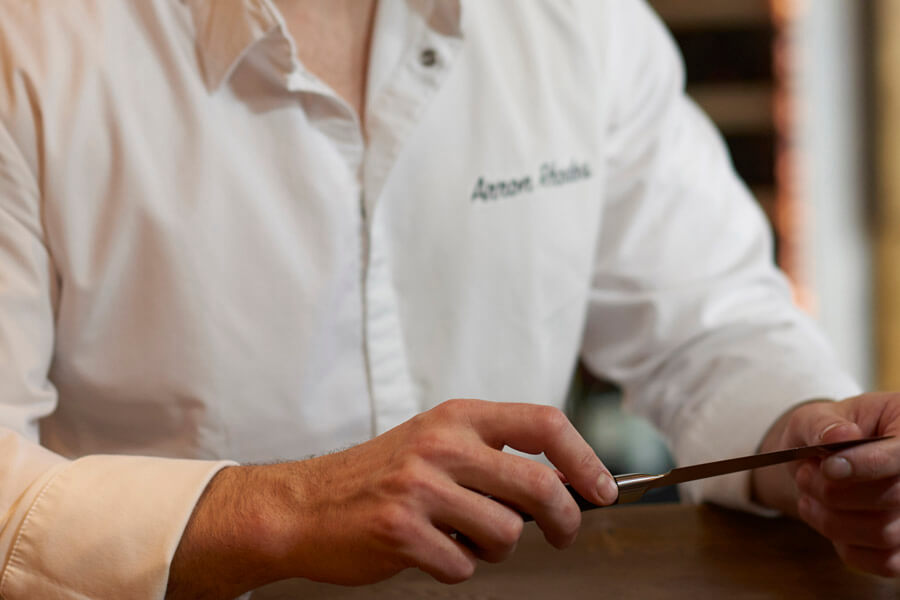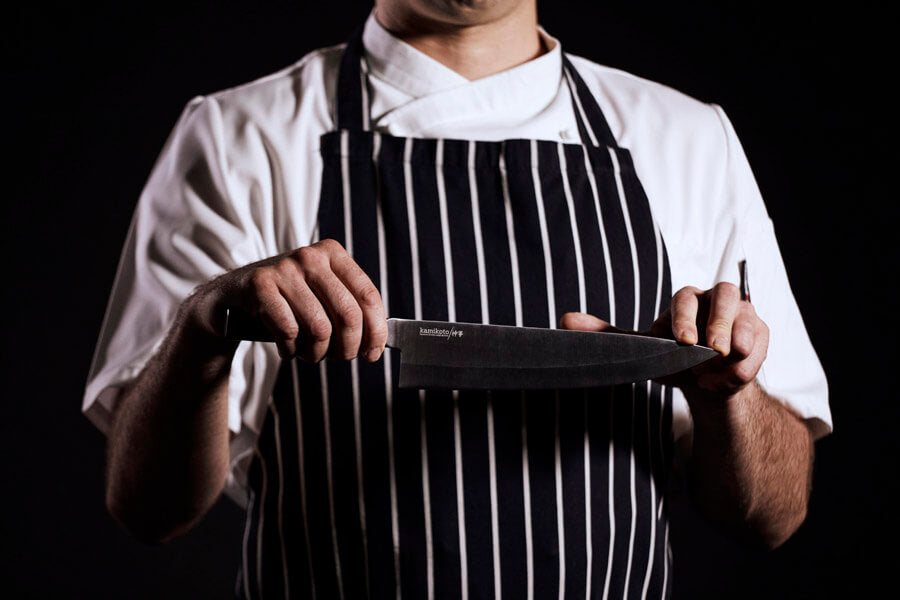
The traditional professional chef’s uniform consists of hat, white jacket and checkered pants. It is steeped in history and chefs who choose to wear it not only do so as a nod to these traditions, but as a mark of the esteem and respect they hold for their profession.
Apart from the history imbued in these garments, each item in this professional uniform also serves a specific purpose in protecting and assisting the chef as they perform their job. Nothing is overlooked from design to fabric to button choice.
The Traditional Chef's Uniform
A traditional chef’s uniform consists of:
- White toque blanche (tall, pleated cylindrical-shaped hat)
- White double-breasted jacket with knotted cloth buttons
- Loose-fitting pants in houndstooth pattern (black and white checks)
The origins of the chef’s uniform dates back to the mid-19th century when the well-known French chef, Marie-Antoine Careme, employed it as a way to honor the work of professional chefs. The hat was already widely in use, but Marie-Antoine instituted the other elements including the choice of white. The uniform was then brought to Western countries by French chef Georges Auguste Escoffier during his reign at renowned London restaurants at the Savoy and Carlton Hotels. Its popularity soon spread worldwide.
Today, many professional chefs continue to wear the full traditional uniform while some opt to forgo the full toque blanche in favor of a skull cap or hairnet.
The Chef's Hat
More than any other piece of clothing, the toque blanche (French for ‘white hat’) is the most recognizable item in a chef’s uniform. When one says the word ‘chef’, the image of a tall, rounded, starched hat with pleats often comes to mind.
From a historical perspective, the toque blanche indicates the chef’s status within a kitchen (their seniority level, knowledge and authority). But it also serves a functional purpose in preventing hair from falling into the food as it is prepared.
The toque has two defining features:
-
The Height of a Chef's Hat
Historically, the height of the hat indicates the chef’s rank – the higher the hat, the more senior the chef. It is rumored that Marie-Antoine Careme’s hat was 18 inches high and needed to be reinforced with cardboard to keep it standing to attention!
-
Number of Pleats in a Chef's Hat
Like hat height, tradition dictated the more pleats featured in a chef’s hat, the higher their experience level. It was said that if a chef had 100 pleats in their hat, that represented the number of ways they knew how to prepare eggs. Today, most chefs do not possess such an extensive amount of pleating, but they still do signify their experience level when it comes to mastering techniques and recipes.
While the toque blanche is the most traditional form of headwear in a fine dining restaurant, there are a number of variations that chefs wear today. Some head chefs prefer a simple skull cap or bandana, while others use disposable food service hats or hair nets.
The choice ultimately comes down to the rules and regulations each restaurant is bound by, as well as the aesthetic they wish to create. For example, some restaurants save the traditional toques blanches for those in charge but others insist all chefs wear the same skullcap to give the impression of a cohesive unit.
The Chef's Jacket

The chef’s jacket has a number of important features and they all center on functionality.
Features:
- Material: made from a heavy cotton material for breathability and to insulate the chef from heat and any splashes of hot liquids.
- Sleeves: chef’s uniforms traditional have either short or longer sleeves. While longer sleeves assists in protecting arms from burns and cuts, shorter sleeves keeps the uniform out of the way, avoiding these hazards.
-
Knotted buttons: plastic or metal buttons have a tendency to chip or fall off, which is dangerous in a professional cooking environment. Knotted cloth buttons circumvent this. They are also much easier to undo should the chef need to remove their jacket quickly in the event of an accident with hot oil or fire.
- Double-breasted & reversible: the double layer serves two functions. It provides an additional layer of insulation against heat or burns. But it can also be quickly reversed should the jacket become stained, enabling chefs to continue with their task, rather than having to stop and change. It is also handy if they are required to present to dining room to speak with patrons.
The Chef’s Pants
Most chef pants are loose fitting to assist with movement and protect against accidental hot spills (close-fitting fabrics hold heat right up against the skin). They also feature a ‘houndstooth’ pattern which is a two-toned (black and white) outline made up of abstract four-pointed shapes. This pattern is very useful in hiding stains and/or dirt.
The Chef's Apron

Although not considered a part of the traditional chef’s uniforms, the vast majority of chefs today wear an apron as an added protection against heat, flames and stains.
A high-quality chef’s apron should be made out of a heavy-duty, flame retardant material. Some chefs also prefer large pockets to enable the safe storage of essential tools they need as they cook.
The Chef's Shoes
Comfort and safety are the two biggest factors to consider when it comes to chef shoes. Expert chefs are on their feet for 10 – 12 hours a day so shoes must be well fitted and possess good shock absorption. For safety’s sake, it is imperative they are non-slip and have steel or reinforced toes to protect against falling pots or a spillage of hot liquids.
There are a variety of shoes on the market but many chefs favor the fit of a clog-based shoe as they:
- Have good traction for moving through the kitchen
- Often feature reinforced toes
- Have extra padding for good shock absorption
- Are shoe-lace free so there’s no risk of tripping over an untied lace
Why do Chefs Wear White?
There are three main reasons professional chefs wear white:
-
Cleanliness
Marie-Antoine felt white was the most appropriate color choice for it symbolizes cleanliness – vital in professional kitchen, both while working but also in the impression it gives customers.
-
Reflective
White reflects heat which offers chefs extra protection from intense cooking temperatures.
-
Bleaching
Even though white shows stains easily, it can be bleached clean.
How to Take Care of a Chef’s Uniform
To ensure longevity, many chefs choose to invest in higher quality uniform pieces. They are generally made of more durable materials, can withstand frequent washing and are more likely to retain their original shape and color so the need for replacements is lessened.
Here are a few key ways to look after a professional chef’s uniform:
- Always take note of - and follow - manufacturer’s care instructions as they can differ from garment to garment.
- Treat stains as quickly as possible to avoid them setting in. Avoid rubbing the stain, and apply club soda or another solution if possible.
- Launder after each shift is over otherwise odors and stains will be more difficult to remove.
- If you're time-poor between shifts, consider using a professional laundry service.
- Use an oxygen-based bleach to refresh chef’s whites after a period of 3 months.
- After cleaning, store uniform safely to avoid any additional mess before starting a shift.
- Only wear the uniform inside the restaurant, not to and from work.
- Invest in spare set or two.
- Know when to replace items once they've become too worn from use.
What Not to Wear in the Kitchen
As previously mentioned, kitchens can be hazardous places with intense heat, hot liquids, sharp utensils and heavy equipment.
To minimize the risk of injuries, one should avoid wearing:
- Open toed shoes such as sandals
- Shoes with low traction
- Uncomfortable shoes
- Clothing made from synthetic and flammable fibers
- Clothing that does not fully cover arms and legs (ie singlets and shorts)
As the information here shows, professional chefs are easily identified by not only the uniform they wear, but by the condition of such items. Taking pride in wearing such a uniform is only befitting of the job they undertake, but also a nod to the heritage inherent in their positions. The right uniform truly is paramount to their level of success as is possessing the right understanding of the best equipment for the job.


